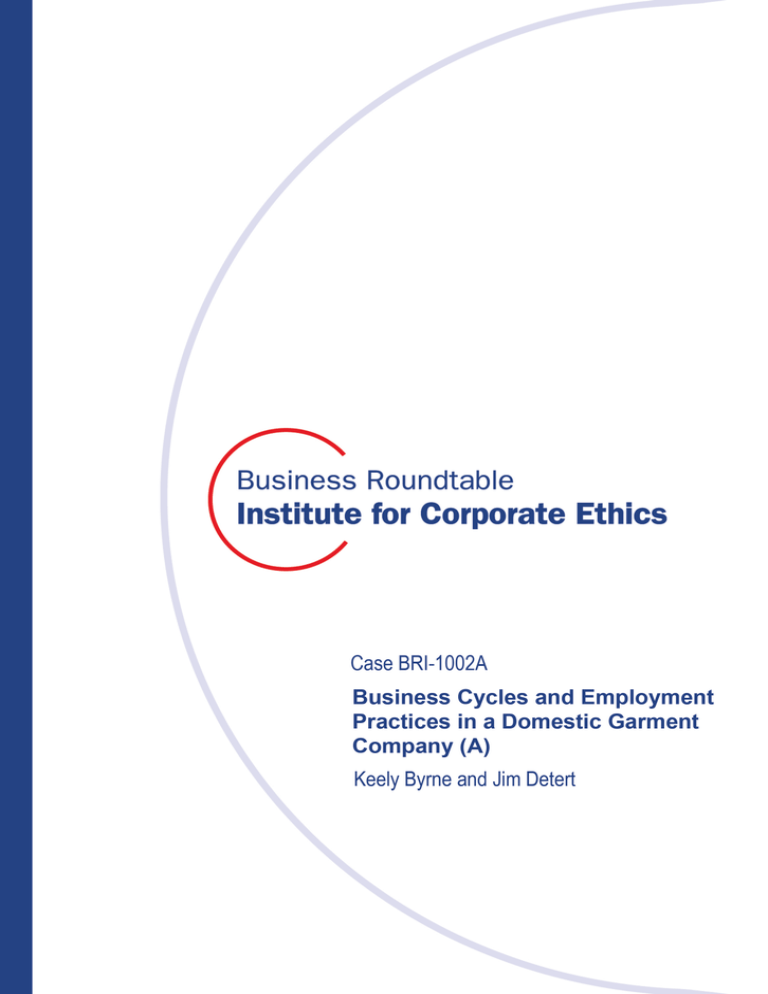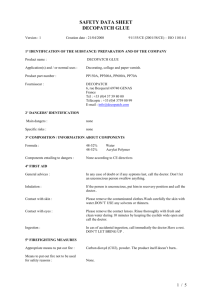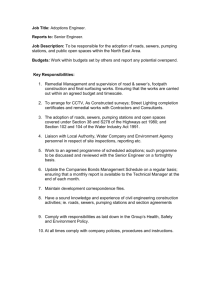
BRI-1002A
BUSINESS CYCLES AND EMPLOYMENT PRACTICES
IN A DOMESTIC GARMENT COMPANY
PART A: MANAGEMENT’S DILEMMA
You are on the management team of a rapidly growing, privately-held apparel company
that had $80 million in sales last year and is projecting $150 million for next year. The
company’s operations are entirely U.S.-based, an anomaly in an industry that has moved almost
all manufacturing to foreign countries in search of cheap labor. Your company has succeeded by
targeting a niche market that will pay more for fashionable styles, making the speed and
flexibility of operations more important than the price. Your company is also unique in its
employee policies. Poor working conditions are common at many apparel factories in the U.S.
and abroad, and the industry is besieged by public criticism of labor practices. Yet a fundamental
tenet of your company is the belief that apparel manufacturing should be profitable without
exploiting workers. Management has worked hard since the company’s inception to treat
employees as well as possible, and it has developed a reputation for these efforts.
This summer your team found the company could not keep pace with orders. You added
a second shift and hired 1,000 new sewers to staff it, bringing the total number of sewers to
3,000. During the summer months, all employees worked fulltime (eight-hour shifts, five per
week) and often overtime to meet sales needs and replenish dwindling inventories.
It is now September, and it has become clear that the company’s inventory is growing too
large. Sales across the industry are usually slow during winter months, and you know the
company must slow its production. Each of the 3,000 sewers assembles an average of 20 dozen
pieces per day. Based on projected orders and the maximum inventory you can afford to carry,
production cannot exceed 4,000,000 dozen pieces between October and March. Therefore, you
must determine how to reduce your actual production over the next 20 weeks to only two-thirds
of full capacity. Wages for sewers are not based on the number of hours they work, but on the
number of pieces they sew. The efficiency of production at your company is partly responsible
for the high wages workers earn.
This case was prepared by Research Assistant Keely Byrne and Professor Jim Detert of the Pennsylvania State
University. Translation between English and Spanish for many interviews conducted for this case was provided by
Professor Tatiana Sandino of the University of Southern California. Copyright © 2005 by the Business Roundtable
Institute for Corporate Ethics (www.corporate-ethics.org). Reproduction and use for direct educational purposes
permitted. All other rights reserved.
-2-
BRI-1002A
Typical industry practice in the U.S. and abroad is to lay off excess labor for the winter
season, with no severance pay or other assistance and no promise of rehire. Many of your sewers
have lost their jobs elsewhere during the slow season for several years. However, if your
company made such a move it would contradict the company’s philosophy regarding the
treatment of employees as valued partners. Laying workers off seems like it would be a
significant defeat in this respect, with possible repercussions in employee motivation and public
relations. Also, your team has invested several thousand dollars in training each employee, and
you are concerned that new sewers may not be skilled enough to meet the steep climb in orders
anticipated in the spring. If workers are laid off, there is no guarantee that you will be able to
rehire the same people in the spring. However, the company cannot afford to pay workers to do
nothing for 20 weeks, and many workers will likely return to the company if they fail to match
your wages or working conditions elsewhere.
How should your management team address the company’s excess labor problem during
the upcoming period of slow sales? Be specific in your recommendations. For example, if you
recommend layoffs, state exactly how many workers will be affected, how you will determine
which workers will be affected, and how this cuts production appropriately. Keep in mind, there
is no union and there are no other specific policies or agreements that mandate the basis (e.g.,
seniority) for prioritizing which sewers might be affected by your decision.










